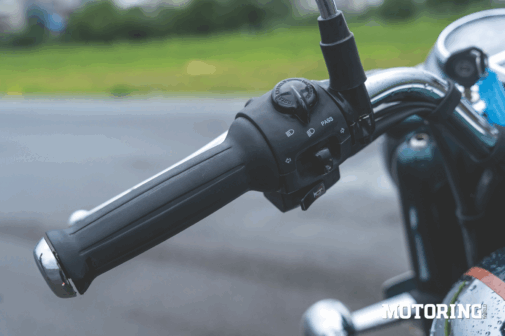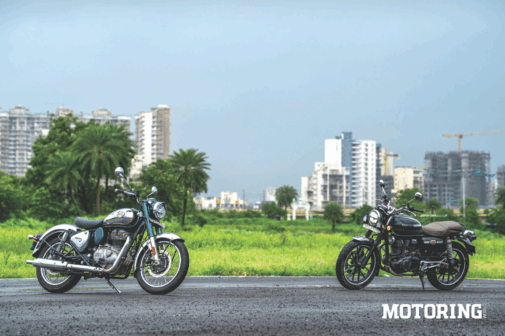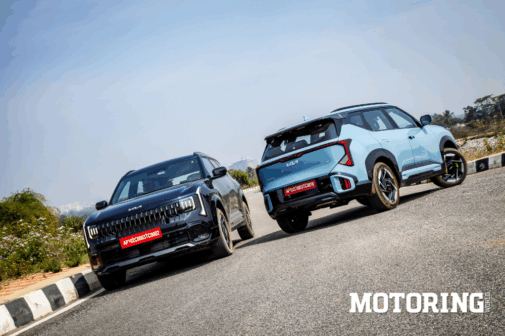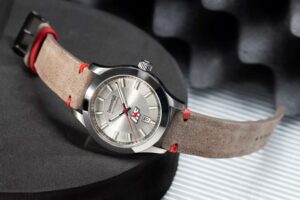We never admit to it. Calling it ‘respect’ is palatable for others, or sometimes it is passed as ‘ambition’, sometimes even ‘competition’, when it’s really admiration. It is only natural, then, that we trace their footsteps, but not because we are lost, but just to see the world from where they stand. Motorcycles are no different, or rather, the people who make them are. Motorsports, sales milestones and sometimes bikes themselves are born of this very emotion.
‘Ambition’
Our country is no stranger to the success story of the Royal Enfield Classic 350. A bike that has embedded itself in our culture, family photographs and into the very soundscape of our roads… and all that in just 16 years. Being the face of ‘wanderlust’ and ‘Got Leh’d’ or being associated with the armed forces is something everyone would want, and trying to achieve that isn’t a bad thing at all. So, when a giant like Honda decided to build a motorcycle in that space, maybe it wasn’t an act of arrogance or imitation, but ambition.
And ambition is never a bad thing, is it? It’s that spark in the chest, the fire in the belly, the quiet refusal to sit still. So, when Honda conceptualised the CB350 H’Ness , it was a statement that the Japanese giant wouldn’t watch from the sidelines. And how could it? The Royal Enfield Classic 350 didn’t just enter the 350cc retro space; it created it. It reshaped an entire segment and, in the process, even outsold the Bullet — the motorcycle that built Royal Enfield’s name.

Over the last six months, the Classic 350 has averaged around 25,000 units a month, accounting for nearly 40 per cent of Royal Enfield’s total sales. Now, who wouldn’t want a piece of this pie, right? But here’s the kicker: in the first half of this year, the combined sales of Honda’s CB350 don’t even match what the Classic moves in a single month. What was missing, then?
‘Innovation’
For a company that built a V5 powered MotoGP machine, developed dual-clutch transmissions for motorcycles, and gave the world the legendary Super Cub, making a simple air-cooled 350cc single should have been child’s play, right?
Honda’s answer was a 348.36cc air-cooled single producing 20.7 bhp and 3.05 kgm — just a shade higher than Royal Enfield’s 349cc motor, which makes 20.2 bhp and 2.7 kgm. To sweeten the deal, Honda added a slip-and-assist clutch to counter the Classic’s heavier lever action.

But the H’Ness didn’t stop at the engine. Every detail was engineered to feel sharper, lighter, more refined. Honda chose the same 19/18-inch wheel setup as the Classic, but offered only alloy rims — so no more roadside wrestling with tubes. The seat sits at 800 mm, just below the Classic’s 805 mm, and rider aids go a step further: traction control paired with dual-channel ABS. Even the 15-litre fuel tank holds 2 litres more than the Classic, yet the bike tips the scales at just 181 kg — a full 14 kg lighter.
In its quest for evolution, Honda also reworked the ergonomics. The handlebar sits slightly closer, and the footpegs are lower and subtly rear-set, creating a natural, easy posture. Add that weight advantage and, on paper, you’re looking at a Classic-killer… aren’t you?
‘Competition’

And it is one, just not the way you think. On the move, the H’Ness feels precise, just as a Japanese bike should. The clutch is light, the gearbox is slick, and the vibrations are minimal… but it doesn’t feel particularly retro. I’m not saying a heavy clutch, clunky shifts, or vibes are a requirement for nostalgia — but they do add a certain texture to the ride.
The new Classic 350 isn’t vibey either, thanks to the J-platform. It’ll sprint gamely to 110 kph before running out of breath, but its true sweet spot is still 80. At that speed, the world around just softens. There’s no urgency to reach anywhere — just me, the bike, and that iconic dug-dug heartbeat. The Honda has a long-stroke thump too, but it feels engineered rather than organic, as though Honda built it to sound like what people expect of a 350, rather than what it really is. If it weren’t for the Classic, would a Honda ever sound like that? Unlikely.

And then there’s the gearing. Unlike the Classic, the H’Ness doesn’t mind cruising at any speed — but you have to be calculated about it. The gearing is too tall for anything except smooth highways. Speed breaker? Drop to second or even first. Sweeping curve? One gear lower and you’ll run out of breath mid-corner; one gear higher and the motor feels flat, forcing you to work around it rather than flow with it.
On the Classic, I never thought about this. I was more concerned about whether it would hold its line if I pushed it harder through corners. On the Honda, I never had to worry about that at all — it behaves almost like a modern naked, planted and predictable, but missing that intangible magic that makes you forgive the flaws.
‘Envy’
A few years after the H’Ness’ debut, Honda even rolled out the CB350 — with chunkier mudguards, a pea shooter exhaust, split seats, and a dash of chrome — a motorcycle dressed to look like the Classic’s twin… or at least a convincing understudy. Sure, the iconic nacelle and unmistakable silhouette of the Royal Enfield can’t be cloned outright, but Honda gave it a fair shot.
So what do we call this? Ambition? Competition? Innovation? Maybe all three. Or maybe it’s just envy wearing its Sunday best. A company as mighty as Honda looked at what Royal Enfield had built — not just a motorcycle, but a movement — and decided it wanted to feel that kind of love, too. And there’s no shame in that. Because at the heart of every great machine, just like in every human, there’s always that little green thread.


















